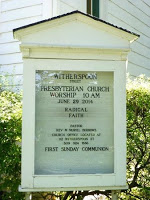| Online: | |
| Visits: | |
| Stories: |

| Story Views | |
| Now: | |
| Last Hour: | |
| Last 24 Hours: | |
| Total: | |
Racial Reconciliation in Princeton
Elesha Coffman
The national wave of student efforts to confront campus racism touched Princeton University last week, with calls to reconsider the legacy of Woodrow Wilson. As reported in the New York Times, the university president responded quickly, promising to address the issue on campus and in discussion with trustees. Meanwhile, a less-reported story of racial reconciliation unfolded just up the street from campus, a story that affirms the value of public church history.
Though located well off the Mason-Dixon Line, Princeton was thoroughly segregated in the early 19th century. “Colored” residents, slave and free (New Jersey began gradual emancipation in 1804 and freed its last slaves in 1865), were restricted to the balcony at the First Presbyterian Church. The church burned in 1835, after an Independence Day rocket landed on its roof, and when the congregation moved into its new building (part of the current Nassau Presbyterian Church), it did so without its African American members. The Nassau website attributes this development to a “continued … separation,” while the website of the church formed by the split, Witherspoon Street Presbyterian Church, reports that the colored members were “dismissed.” Whatever its precise origin, the division persists, with the two churches standing a mere 0.3 miles from each other. They did, however, symbolically move closer together last week.
As reported not in the New York Times, but in the local Town Topics and Planet Princeton, more than a decade ago the Rev. David Prince, the interim pastor at Witherspoon Street, and his wife, Nancy, began researching the church's history. In addition to the ugly separation in the 1830s, they discovered that in 1900, whites orchestrated the removal of the pastor at Witherspoon Street, Rev. William Robeson, because he was advocating forcefully for racial justice. Rev. Robeson was the father of singer, actor, and Civil Rights activist Paul Robeson, whose legacy is remembered at Princeton's Paul Robeson Center for the Arts, located between the two churches. (If you didn't catch the NPR story on Paul Robeson's performance of “Ballad for Americans” the other day, you should listen to it now.) Under pressure, Rev. Robeson left his 21-year post at Witherspoon Street and became a minister in the African Methodist Episcopal Church.
To uncover this history, Nancy Prince undertook the same kind of work we all know well, reading biographies of the Robesons and scouring documents at the Presbytery Historical Society. (Presbyterians have many flaws, but they do keep good records.) She decided to press for a public apology for Robeson's ouster. In the end, she got even more.
On November 15, the Witherspoon Street church celebrated its 175th anniversary with a banquet. A representative from Nassau Presbyterian read a letter stating, “We lament the sins of our forebears and acknowledge the institutional complicity of the First Presbyterian Church in our community's hesitance to embrace the abolition of slavery and, thereafter, our community's participation in the establishment and maintenance of Jim Crow segregation.” The Presbytery of New Brunswick apologized for the unwarranted removal of Robeson, and the Synod of the Northeast donated nearly $175,000 to help the church pay off the mortgage on the former Robeson house and turn it into a study center. David Prince died last year, but Nancy was present to see the results of her labor.
It is too soon to declare a reconciliation victory in either Princeton's churches or its university, but the Witherspoon Street story is a clear win for public history. It also suggests that the university might yet have things to learn from the religious tradition it left a century ago.
A Group Blog on American Religious History and Culture
Source: http://usreligion.blogspot.com/2015/11/racial-reconciliation-in-princeton.html




